Orchids vary in size, shape, fragrance, growing conditions, and almost every other category that you can imagine. With over 9,000 genera of orchids that have been scientifically catalogued, each with different species (around 30,000 different species) it’s a little hard to know which orchids will grow in our living room. The truth is, not all will.

Some orchids need special conditions to grow successfully:
proper lighting,
humidity,
ventilation,
pH of the water,
and other variants.
These can only be successfully grown in greenhouses and specialized locations. When it comes to picking out orchids to grow indoors though, the list can narrow significantly.
What are the best orchids to grow indoors? Phalaenopsis, Cattleya, Paphiopedilum, Dendrobium, Cymbidium, Ludisia, Miltoniopsis, Oncidium, Phaius, and Zygopetalums are the best orchids to grow indoors without many adaptations from the homeowner.
Let’s look at how to grow these indoors and what you’ll need to make these orchids thrive.
Please note that this article is not a full guide to each orchid, just a revised version. To see more about each specific orchid and how to accommodate your house to better imitate their environment, see other complete guides to growing orchids in the LEARN section.
1) Phalaenopsis (Moth Orchid): the number one indoor grown Orchid
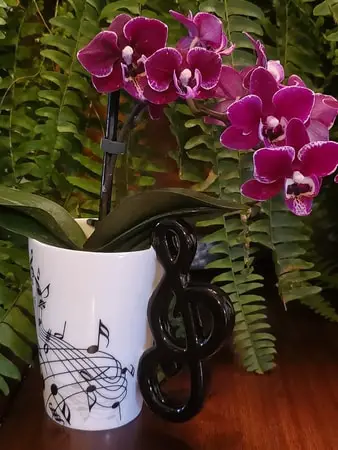
Phalaenopsis are by far the most sold indoor orchids on the market.
These make perfect gifts for Mother’s Day, Valentines, birthdays, graduations, and other special occasions.
They are so common that you can find them in department stores, grocery stores, and supermarkets. To best accommodate a Phalaenopsis orchid in your living room, you’ll need to focus on two things: light and humidity.
Chose a window sill that sits in light location, but doesn’t get direct sun. I personally refrain from saying east or west windows, since I don’t know what’s on the other side of your window or how wide your overhang is. You might put it in an east window and there be absolutely no light whatsoever.
So chose a window that is well-lit, but has no direct sunlight pouring through it during the afternoon hours. A couple minutes in the morning sun or late afternoon sun are doable, too. Phalaenopsis love being in well-lit windows, where air flow is constant and its bright light illuminates the environment.
A good place for it is the kitchen window, above the sink. As long as you take extra care and don’t pour boiling water in the sink where the fervent steam will scar the orchid leaves, then the kitchen window is perfect. The constant humidity will be appreciated by the orchid.
Tips: Don’t keep bananas or ripe oranges near the Phalaenopsis. These fruit (others too, but these are the worst) will excrete a chemical gas called ethylene when they are near ripe. This is extremely toxic to the orchid and it won’t bloom.If you don’t want to keep the orchid in the kitchen, and prefer the living room, add a humidity tray under the orchid. Phalaenopsis have a higher humidity preference than most indoor environments provide. You can easily make a humidity tray, if you follow the instructions in this article.
You’ll want to start with the Phalaenopsis orchid and once it’s successful, move on to the next. This is the perfect beginner orchid. Read the full beginner’s guide here.
2) Cattleya: Indoors is Perfect for This Orchid
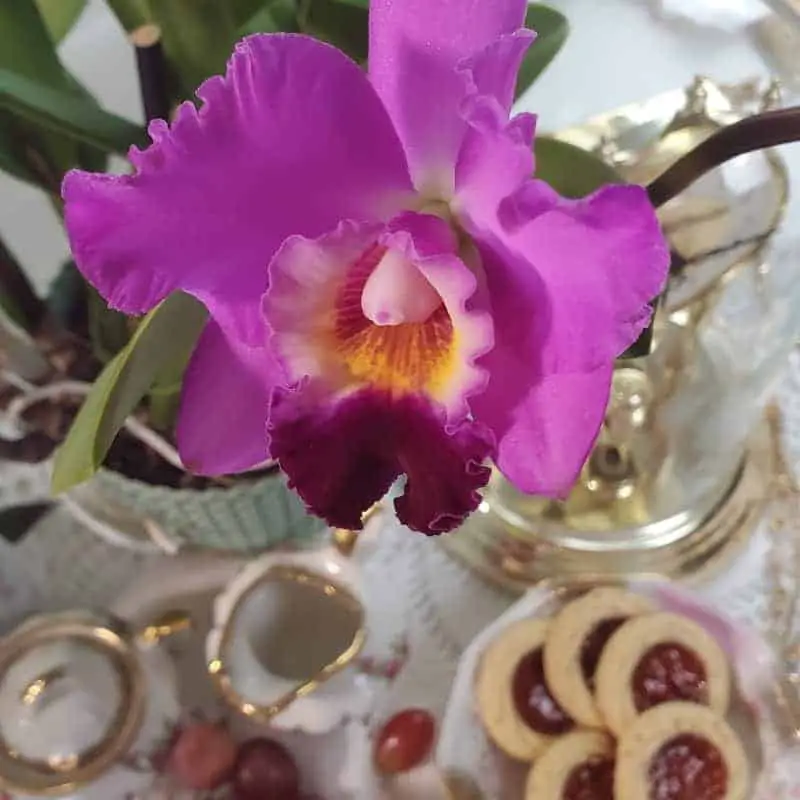
Cattleyas are another orchid that are easily grown indoors. They come from the tropical and subtropical forest in Brazil.
These are excellent orchids to attach to trees or place on mounts, since that is their most likely habitat.
The only challenge for Cattleyas is not enough air circulation in your living room. Adapted to grow windy environments, Cattleyas will develop root rot quickly if there is not air circulation.
You’ll need to keep a low fan on all the time. If you don’t want to use a fan, you can place your Cattleya on the patio outside during spring to fall. Just keep it out of direct sunlight, or at most, allow early morning sun. If you live in a hardiness zone of 10 to 12, you’re in the perfect spot for an outdoor Cattleya.
Otherwise, keep in indoors with a low fan.
Once the fan is on or it is outdoors, your humidity levels will drop. This is a double hit because Cattleyas prefer a lot more humidity than the Phalaenopsis do. A humidity tray just won’t cut it, and with the fan on low during both day and night, you’ll need to provide a humidifier.
Cattleyas prefer a 40 to 70% humidity range, and most indoor environments are around 33%. It’s worse if you work in an air-conditioned room. By the way, I suggest these five humidifiers, all that are in a good price range, if you happen to go that route.
Tips: Lots of new orchid hobbyist will place an orchid in the bathroom thinking that the humidity will benefit the orchid. Please don’t do this. The humidity forms the bathroom is sporadic and inconsistent. It can be the driest place in the house, then all the sudden move to 100% humidity for ten minutes. Then after a while, it drops down to the direst place ever. This inconsistency will halter the orchid’s growth. The same can be said about temperature. Usually the humidity that is produces in the bathroom is from hot showers, and the temperature ranges are not the best.
The last reason I’m against bathroom orchids is that the lighting is usually not adequate. Most bathrooms stay in the dark unless someone is in there and turns on the light. Unless you have “to-die-for” bay windows over the sunken tub, most small windows provide the lighting that an orchid’s needs.
In all, bathrooms don’t favor an orchid.
Once you’ve managed humidity and air circulation, your Cattleya will thrive indoors and make your living room all that much brighter. Need more information on Cattleyas? Read this beginners guide to growing Cattleyas.
3) Paphiopedilum: The Indoor Orchid that acts like other houseplants
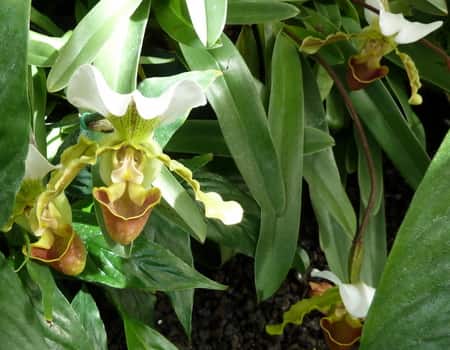
Paphiopedilums (also called lady slippers or moccasin orchids) are some of the few orchids that are terrestrial. Everything you’ve learned about potting medium and orchid bark, sphagnum moss, and perlite can be ditched when it comes to Paphiopedilums. Being terrestrial, these orchids act like other houseplants grown in soil.Except they still are orchids, so don’t use houseplant soil.
A good mixture for a potting medium would be four parts bark and one part perlite. This ensure the proper drainage that Paphiopedilums like and also ensure that the roots are always a little moist. You’re aiming at a medium that provides great drainage over anything else.
The main concern with Paphiopedilums is watering them enough so they stay moist the entire time. This may mean you’ll have to water them more than your Phalaenopsis.
There are two types of Paphiopedilums: a warm-growing type (70ᵒ to 80ᵒ F or 21ᵒ to 26ᵒ C during the day) and a cool-growing type (65ᵒ to 70ᵒ F or 18ᵒ to 21ᵒ C during the day). Warm growers are best for indoors, since the cool growers demand daytime temperatures that are cooler than most people are comfortable with. (Nighttime temperatures are similar among both types (55ᵒ to 62ᵒ F, 12ᵒ to 16ᵒ C).
So when you’re browsing Paphiopedilums, chose a variety that is a warm-grower.
4) Dendrobium: Indoors Makes these Orchids Thrive
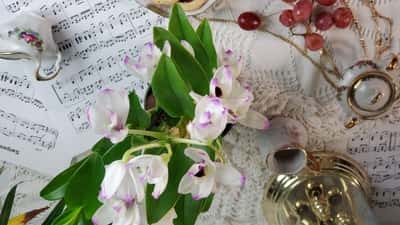
Dendrobiums will be one of the few orchids that will like a window that does get a bit hotter during the day.
I’m not much on dictating which directional window to choose, but if all windows are the same, pick a south-facing window for your dendrobiums. You can keep a small humidifier by your orchid and turn it on a few times a day if you want to isolate it form the rest of your orchid collection.
The reason for this is dual: they love the hotter climates and temperatures during the day, but need a cool wind or breeze at night to bring the temperatures down.
Most orchids do not tolerate being in sunlight, but dendrobiums don’t mind as long as it’s not all day long. During the hottest part of the day, they’ll need shade. This is why the south window works best (that is, if you live north of the equator).
Dendrobiums will also need more water and more fertilizer than your other orchids. In fact, just relate Dendrobiums to being greedy and wanting everything: all the sun, all the water, and all the fertilizer. In this sense, you’ll need a humidifier for these, too. They’ll want higher humidity levels, aiming for 50 to 70% relative humidity (rH). This is a little higher than the other orchids listed, so place the humidifier closer to the Dendrobium.
5) Cymbidium: The least of Indoor Orchids, since they like the Patio
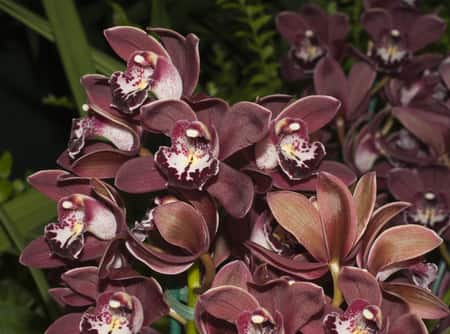

I debated whether to place Cymbidiums on this list, since these orchids have a wonderful time outdoors.
From spring to fall, they will do well on a bright porch or patio, as along as they aren’t in direct sun for more than two or three hours. But during winter they have to be brought indoors, so that is why they made a spot on my list. Since some Cymbidiums blossom during winter, they make the perfect peaceful place for winter blues. You can read the full care guide for Cymbidiums here.
What you’ll want to check for in Cymbidiums is proper water drainage and humidity. As long as water is constantly around these orchids, (roots always moist but not mushy) they’ll do well either indoors or outside.
To maintain higher humidity in a drier climate, you’ll need to mist the leaves each morning and night, along with the proper watering schedule. In climates that aren’t so dry, a daily morning mist should be sufficient.
6) Ludisia: A Miniature Orchid Worthy of a Majestic Indoor Throne
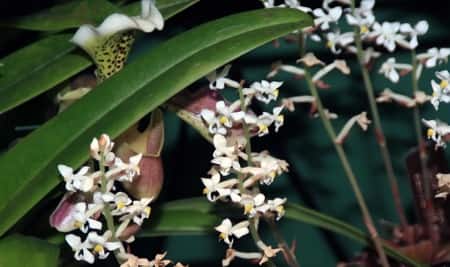
What I love about Ludisia (or jewel orchids) is that their leaves are fascinating. Most orchids have leaves that don’t call much attention, but Ludisia orchids have beautiful patterns, shapes, intricate designs and just mesmerize me.
And the best part: when they flower, they produce tiny, miniature flowers that are just to fall in love with. You have a double winner on this indoor orchid.
Ludisias make the perfect terrarium orchids, too. If you plant them in a terrarium, they keep the colorful vibe up all year round, even with out the blossom.
If you grow African violets, then Ludisia is definitely the orchid you’ll want. The growth patterns and environments are extremely similar, not to say the same. If happen to have the winter blues, the Ludisia is a winter bloomer and will be ready for repotting near March (Spring).
And the best part of a Ludisia orchid: it’s a terrestrial orchid. Unlike the Paphiopedilum which is also terrestrial, Ludisia actually like soil. So if you have any left over potting mix that isn’t orchid related, Ludisias adapt perfectly well to soil and garden mixes.
7) Oncidium: The Queen of the Indoor Dancing Ladies
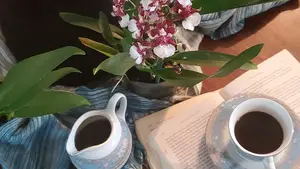
Oncidiums (otherwise known as Dancing Ladies or Tiger Orchids) are a humongous orchid genus.
The American Orchid Society has classified and accepted 300 orchids in this genus, and from there, the hybrids branch out.
Oncidiums even have an Oncidium Alliance, with over 70 Oncidium genera and these branch into over 1,200 species. For this reason, it’s hard to write a specific care guide since they are grown in almost every single type of habitat there is: Brazil, Peru, Andes, Columbia, Hawaii, Florida, and so on… They grow anywhere from coastal ranges to the mountains.
What you’ll need to do is research the specific orchid species of the Oncidium you’re wanting to cultivate and take the care instructions from there. If you’re undecided, try the Shery Baby, which has a unique fragrance of chocolate.
(Not recommended if you’re on a diet. That’s like torture, as I found out. Try working in your home office with chocolate scent circulating the room… Not fun.)
I’ve decided to write about the Oncidium variconsum (or the veined Oncidium) since this is what my mother grew before I even had the slightest interest in orchids. It’s special to me because that’s how I remember her, and what drove my initial passion for orchids.
These oncidiums tolerate higher light than most orchids, except they don’t like the direct sunlight for too long. As long as your window is extremely light and some sun does get through, your oncidiums will love it.
You will need a higher plant stand for this orchid. It’s long flowers spikes and flower down and cascade into the most beautiful yellow spray of flowers I’ve ever seen. I know I’m biased, but hey… It’s just amazing. In Portuguese, these are known as the “golden rain”. Just by thta descriptive name, you get the idea of how extravagant they are.
For these, you’ll also need a humidifier. They like a lot higher humidity than the other orchids do, and need to be repotted sooner also.
They don’t tolerate broken down media and will be the first to complain. Most orchids can make it two years maybe three without a necessary repot, but not Oncidium variconsum. They like to be repotted as soon as the first signs of decomposing potting medium occurs.
8) Phaius Orchid: The Indoor Giant
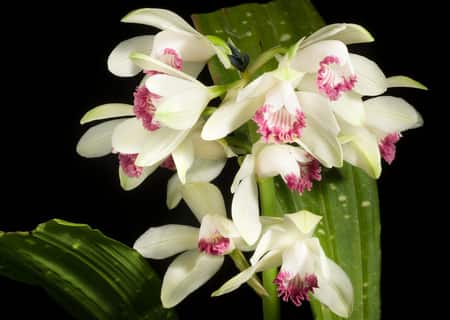
Phaius orchids (the most common is Phaius tankervillleae or nun’s orchids) are not usually known among new orchid growers, even though they had 43 species and 2 subspecies. I’m not sure why this is, since they are extremely easy to grow indoors. Actually, there are probably the easiest orchids to grow on this list.They are so easy that if you grow them exactly like your other houseplants, they’ll do fine. The only advice on the Phaius orchids is that they don’t like misting on their leaves. Other orchids don’t mind, and actually like to have an occasional mist to keep the humidity up. Not Phaius. Keep the water schedule to twice a week only on the roots during summer and weekly during winter, and you’re good to go.
The one downfall of this orchid (is it a downfall? I’m not sure. Maybe not.) is that it grows quite tall. You’ll need two to three feet of space to properly store this orchid indoors.
They are terrestrial orchids, so you’ll need to follow the same mixture of potting media that your Paphiopedilum and Ludisia grow in.
9) Miltoniopsis: The Indoor Water Lover
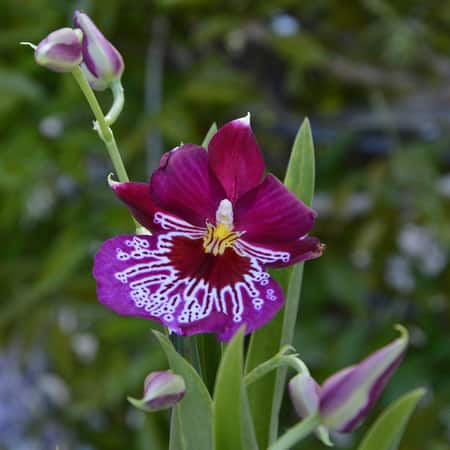
The Miltoniopsis Orchids (which look like little pansies) are grown naturally in the higher mountainous regions of the Andes, around Peru, Colombia, Panama, and Ecuador, where it rains almost every single day.
They absolutely love water, and if you want to try your hand at a semi-hydroponic method, then this is your orchid. You could try either full hydroponics or semi, but either way, Miltoniopsis will appreciate the higher water and humidity.
To grow these indoors, you’ll have to be very strict about the water and cooler temperature. Everything else is pretty easy to maintain, as far as fertilizer, lighting (they don’t like much, so keep them in bright shade, less than Phalaenopsis), and potting medium are easy to tend to.
What isn’t easy, is the humidity. Watering and humidity are two different things, and Miltoniopsis like them both are very high levels. You’ll need to keep a humidity tray and a humidifier, since they thrive at 70% rH. Just because of this factor, Miltoniopsis almost didn’t make it onto my indoor list. At 70%, you’re risking the wall paper to peel off and the paint to crumble with moisture.
The only way this works indoors is if you keep a humidifier pointed directly at the Miltoniopsis, and place both by a cool window. This keeps the air circulation high, not letting the high humidity accumulate around the crown and stem.
This is probably the hardest orchid to grow on this list just because of humidity and because of the cooler temperatures, so start with another one first until you get the general idea of orchid care.
Once you’ve kept an orchid alive (and believe me, don’t feel bad if you kill the first couple orchids—it happens. Orchid care is a learning process) then move onto the Miltoniopsis. Your reward will be a large pansy looking flower, which is very similar to the Cymbidium.If you’re interested in how to grow Miltoniopsis Orchids, this article I wrote is a care guide for Miltoniopsis, and is a good place to start.
10) Zygopetalums: The Indoor Mounted Orchid
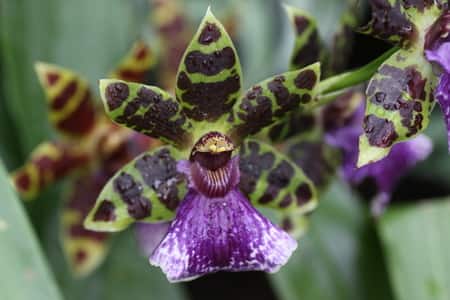
To the last orchid on my list is one that is easily mounted and will thrive better mounted than in a pot. Zygopetalums will not forgive a soggy potting medium, and the roots will be the first to complain.Their potting medium must have fast drainage, that leads the water in and out of the pot in no time. This is why mounting Zygopetalums are the best way to keep their roots dry between watering.
What you’ll want to note about Zygopetalums is that they’ll need extra additives in the fertilizer to really take on growth. If you’re new to fertilizer, check out this article so you’ll know what to expect and how to properly fertilize your orchids.
Don’t Stop Learning!
If you want to be included in more information and get a 14-page fertilization guide, please sign up for my newsletter. I don’t spam, but send emails out bi-monthly with some curious topics of interest. If you want more information, click here to go to a specific page on this website where I explain it more in detail.

Also, if you are looking for an orchid journal to keep your notes specifically about orchid care, check out my 2 solutions for that on this page. If note-keeping isn’t your thing, then there is a free excel spreadsheet that you can download. Click here for more information on how to do that.
If you subscribe to my newsletter, I will send you a 14-page guide on the main tips of orchid fertilizer. It is downloadable and you can print it out on your computer. I designed the guide to double up as a coloring book, just to make it fun.
(By the way, if you subscribe to the website, you’ll get a free coloring-booklet that talk all about fertilization that you can download and print.) To your normal fertilization process, you’ll need to add dolomitic lime. This will help the leaves be less prone to damage and tear.These are just the top 10 orchids that can be grown indoors. If you can’t find these at your local store, you can search online. If you need tips and suggestions for online orchid shopping, check out this article.
If you have already tired these 10, then it’s time to start expanding your collection to the next 10 orchids that are excellent for houseplants. These include: Brassavola, Catasetum, Cycnoches, Encyclia, Epidendrum, Lycaste, Masdevalia, Phragmipediums Psychopsis, and Vanda. You can read more about this second list in another article.
Happy Cultivating!


First of all, thank You very much for such interesting articles and comments … very enriching to read. I myself struggle far north in Sweden with my orchid collection … it is not large and includes close to 200 species.
Well … I do feel a little confused when I read Your words about Miltonia.
Thrue Miltonia hybrid are often named as Miltassia, Miltonidium etc.
Cold-loving brazilian Miltona are located as Miltoniopsis… unfortunately they are still sold as Miltonia.
Your description of Miltonia above applies in my eyes to Miltoniopsis and not Miltonia which is relatively easy to care for on a windowsill. Am I right? Or have I misunderstood Your post?
Hi Dorra,
Thanks for your question. Far north of Sweden! Oh wow! I can only imagine how beautiful it is. 🙂
Miltonias are a lot easier to care for in my opinion since they can be grown in the same conditions are the most common orchids, as warm-growers. Miltonias can be grown on window sills for this same reason. Miltoniopsis like it much cooler, which in your climate, might do better, so a window sill is also ok. A lot of orchid care is adapting the orchid to your home environment and your routine, so the articles I write about Kansas, might not be the same as your climate. If you want, this article is a better explanation of the differences between Miltonia and Miltoniopsis: https://orchideria.com/miltoniopsis-care-guide/
Can you tell me what specific part of the article was confusing? I can go back and rewrite it. 🙂
-Amanda
*Update: Oh my gosh, Dorra! I just realized what you are talking about! I was thinking it was a different article, the one I mentioned above! But your comment was for this specific article! Yes, you are absolutely correct! It is supposed to the Miltoniopsis! Thank you for pointing that out! I’ll go change Miltonia to Miltoniopsis asap! 🙂